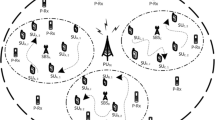Abstract
The problem of analyzing various methods for the formation of the classified training sample that ensure the effective operation of the automatic compensator for active interferences with simultaneous presence of passive interference is solved in this paper. For the first time an adaptive method for the formation of the classified training sample based on the use of threshold estimation of the interchannel correlation coefficient of the combined interference is proposed. An adaptive method for the formation of the classified training sample based on the current interval estimation of the distribution of the passive component of the combined interference in range (time) is also proposed. The method provides an estimation of the coefficient of interchannel correlation with the selection of the maximum value and its utilization for the formation of weight coefficients in the following probing period. Experiment in the testing ground is conducted with a quantitative estimation of the cancellation ratio of active interference for the formation of the classification sample using spectral differences in the structure of active and passive interferences.
Similar content being viewed by others
References
Ya. D. Shirman, V. N. Golikov, I. N. Busygin, et. al. Theoretical Foundations of Radiolocation. Textbook for Universities [in Russian, ed. by Ya. D. Shirman] (Sov. Radio, Moscow, 1970).
A. K. Zhuravlev, V. A. Khlebnikov, et. al. Adaptive Radio Systems with Antenna Arrays [in Russian] (Izdat. LGU, Leningrad, 1991).
R. A. Monzingo, T. W. Miller, Introduction to Adaptive Arrays (Wiley, 1980).
Jack Gordon McQueen, “Adaptive cancellation arrangement,” UK Patent 1 599 035, G01 S 7/36 13/52 (30 Sep. 1981), index at acceptance H4D 259 265 36X 40X. URI: http://www.directorypatent.com/GB/1599035-a.html.
Joseph F. Len, Peter M. Rankin, “Frequency agile-baseband sidelobe canceller arrangement,” US Patent 3881177, G01 S 7/36 (29 Apr. 1975), appl. No. 450, 543, URI: http://www.google.com/patents/US3881177.
V. P. Riabukha, D. S. Rachkov, A. V. Semeniaka, Y. A. Katiushyn, “Estimation of spatial weight vector fixation interval for sequential space-time signal processing against the background of combined interferences,” Radioelectron. Commun. Syst. 55, No. 10, 443 (2012). DOI: 10.3103/S0735272712100020.
A. P. Zalevsky, D. M. Piza, I. S. Presniak, A. S. Sirenko, “Coherent-pulse radar signals space-time and time-space filtering performance evaluation,” Radio Electronics, Computer Science, Control, No. 2, 39 (2012). DOI: 10.15588/1607-3274-2012-2-7.
J. W. Taylor, G. Brunins, “Design of a new airport surveillance radar (ASR-9),” Proc. IEEE 73, No. 2, 284 (1985). DOI: 10.1109/PROC.1985.13139.
I. D. May, A. G. Kaspirovich, V. A. Vynnyk, et. al. Radar 36D6M. Exploitation and Technical Maintenance: Textbook [in Russian] (SPC Iskra, Zaporizhzhya, 2006).
B. Widrow, S. D. Stearns, Adaptive Signal Processing (Prentice-Hall, N. J., 1985).
V. Ya. Kononovich, A. P. Kukolnitsky, O. P. Zalevsky, O. G. Kaspirovich, Yu. L. Metster, A. A. Deneka, “Compensation method for active component of combined interference,” UA Patent 48705, IPC G01S 7/36. State Enterprise “Scientific and Production Complex “Iskra”. Bull. Izobr., No. 6 (25 Mar. 2010).
D. P. Bespalov, et. al. Atlas of Clouds. Federal Service for Hydrometeorology and Environmental Monitoring (Roshydromet), Main geophysical observatory named after A.I. Voeikov [in Russian, ed. by L. K. Surygina] (D’ART, St. Petersburg, 2011).
D. M. Piza, O. P. Zalevsky, O. V. Rudyk, “Method of coherent-pulse radar protection from combined interferences,” UA Patent 59472, IPC G01S 7/3b. Applicant and patent owner Zaporizhzhya National Technical University. Bull. Izobr., No. 9 (10 May 2011).
D. M. Piza, A. S. Sirenko, “Protection method of coherent-pulse radars from combined interferences,” UA Patent 78120, IPC G01S 7/36. Zaporizhzhya National Technical University, Bull. Izobr., No. 5 (11 Mar. 2013).
V. D. Anokhin, F. Simokhamed, Ye. V. Anokhin, V. G. Kildyushevskaya, “Compensator of active interferences,” RF Patent 2444751, IPC G01S 7/36. Applicant and patent owner: Federal State Higher Professional Educational Institution “Military Aviation Engineering University” (Voronezh), Ministry of Defense of Russian Federation. Bull. Izobr., No. 30 (10 Mar. 2012).
D. M. Piza, A. S. Sirenko, Ye. O. Zviagintsev, “Method of radar protection from combined interferences, acting via main beam of antenna radiation pattern,” UAPatent 91114, IPC G01S 7/36. Zaporizhzhya National Technical University. Bull. Izobr., No. 12 (25 Jun. 2014).
Author information
Authors and Affiliations
Corresponding author
Additional information
Original Russian Text © D.M. Piza, G.V. Moroz, 2018, published in Izvestiya Vysshikh Uchebnykh Zavedenii, Radioelektronika, 2018, Vol. 61, No. 1, pp. 47–54.
The study is performed according to the research topic of the Zaporizhzhya National Technical University “Development of recommendations for the construction of space-time signal processing systems under conditions of combined interference” (State Registration No. 0114U002636). The authors are grateful to the Ministry of Education and Science of Ukraine and the State Enterprise “Scientific and Production Complex “Iskra” for financial support of the conducted studies.
About this article
Cite this article
Piza, D.M., Moroz, G.V. Methods of Forming Classified Training Sample for Adaptation of Weight Coefficient of Automatic Interference Compensator. Radioelectron.Commun.Syst. 61, 32–37 (2018). https://doi.org/10.3103/S0735272718010041
Received:
Published:
Issue Date:
DOI: https://doi.org/10.3103/S0735272718010041




